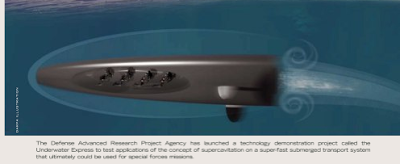From 2007, seapower digital has more information on the Underwater Express program. Underwater express is a DARPA project looking to create a 100 knot (110 mph) submarine that is 8 feet in diameter and 60 feet long and would not have a surface signature. It would replace a 40 knot speedboat for special forces. It would probably have a thermal power source (maybe a nuclear engine or a diesel engine) that would power water jets. A speedboat also makes a lot of noise so sonar/sound detection would not be different, but an underwater delivery would have nothing to spot on the surface and would be over twice as fast. There is the challenge of detecting obstacles and controlling the supercavitating craft when surrounded by an air pocket when sonar and sensors are useless.
One way around the issue is that blue lasers can be used to communicate through water, so a satellite or plane could provide an updated feed of what obstacles are in the path or are around the superfast submarine.
Potentially supercavitation could reduce drag by one thousand times (the difference in drag between water and air. Current supercavitation technology reduces drag by abougt 60-70%.
The supercavitating underwater missile is a technology demonstration program for close-in defence against underwater targets. It is equipped with a solid-propellant rocket motor, inertial measurement unit, autopilot and a conical tip which can be moved by means of an actuator system. The rocket motor provides the missile with a submerged speed of more than 400km/hr. The inertial measurement unit and the autopilot stabilize the missile so that the heading is held. The flexible nose cone provides steering just as a missile’s fins do. Due to its high submerged speed, it moves in an air bubble, the so-called cavitation bubble, wherein almost vacuum prevails, thus greatly reducing its water resistance and enabling the high speed. To date, around a dozen test models of the underwater missile have been built and tested successfully. The tests focused on stabilization, guidance and maximization of agility, which is of great advantage for engaging rapidly moving underwater targets. The supercavitating underwater missile is suited for use from submarines and surface vessels.
This would involve mastering the reduction in drag from 60-70% to many times better. They consider supersonic aircraft carriers and versions of jet fighters underwater. The site has a lot of cool looking graphics. (copyrighted to so go to the link to see them). Empire the film also suggest nuclear powered vessels that use nuclear power to generate hydrogen from seawater to build up fuel for the rockets that power the supercavitation propulsion.
Supercavitating Catamaran/Trimaran Pontoons
The poontoons of a catamaran or trimaran could have supercavitation installed to reduce drag by 60-70% (or more for more advanced versions) to enable higher speed surface cargo transportation. A 70% reduction in drag would mean you could go 1.8 times faster using the same amount of power (72 knots instead of 40 knots). A 90% reduction in drag would mean 3 times faster for the same power (120 knots instead of 40 knots).
Applying Stealth to Supercavitation
The speed of sound in seawater that is free of air bubbles or suspended sediment, sound travels at about 1560 m/s. In dry air at 20 °C (68 °F), the speed of sound is 343 meters per second (1,125 ft/s). This equates to 1,236 kilometers per hour (768 mph), or about one mile in five seconds.
A supercavitating vessel could make a lot of noise. Applying stealth would be to reduce the sound and to direct the detectable sound away from sensors in a predictable way. Being able to alter the detectable signature or create or have unmannded decoys could be useful. Also, by travelling at high speed and possibly having the sound that is given off being not that much faster, the supercavitating vessel could use a detectable burst of speed and then go into silent and stealth mode. It would be known that the supercavitating vessel is in a general area but it would not be known exactly where it was.
Supercavitation ventilation patent
Some consideration of supercavitating hydrofoils

Brian Wang is a Futurist Thought Leader and a popular Science blogger with 1 million readers per month. His blog Nextbigfuture.com is ranked #1 Science News Blog. It covers many disruptive technology and trends including Space, Robotics, Artificial Intelligence, Medicine, Anti-aging Biotechnology, and Nanotechnology.
Known for identifying cutting edge technologies, he is currently a Co-Founder of a startup and fundraiser for high potential early-stage companies. He is the Head of Research for Allocations for deep technology investments and an Angel Investor at Space Angels.
A frequent speaker at corporations, he has been a TEDx speaker, a Singularity University speaker and guest at numerous interviews for radio and podcasts. He is open to public speaking and advising engagements.




